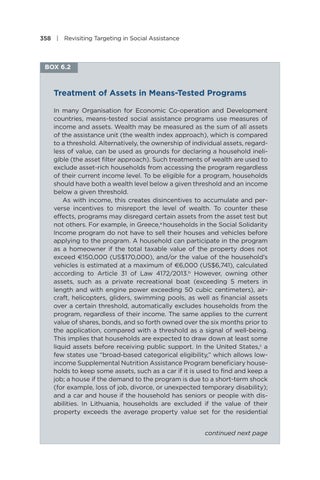358 | Revisiting Targeting in Social Assistance
BOX 6.2
Treatment of Assets in Means-Tested Programs In many Organisation for Economic Co-operation and Development countries, means-tested social assistance programs use measures of income and assets. Wealth may be measured as the sum of all assets of the assistance unit (the wealth index approach), which is compared to a threshold. Alternatively, the ownership of individual assets, regardless of value, can be used as grounds for declaring a household ineligible (the asset filter approach). Such treatments of wealth are used to exclude asset-rich households from accessing the program regardless of their current income level. To be eligible for a program, households should have both a wealth level below a given threshold and an income below a given threshold. As with income, this creates disincentives to accumulate and perverse incentives to misreport the level of wealth. To counter these effects, programs may disregard certain assets from the asset test but not others. For example, in Greece,a households in the Social Solidarity Income program do not have to sell their houses and vehicles before applying to the program. A household can participate in the program as a homeowner if the total taxable value of the property does not exceed €150,000 (US$170,000), and/or the value of the household’s vehicles is estimated at a maximum of €6,000 (US$6,741), calculated according to Article 31 of Law 4172/2013.b However, owning other assets, such as a private recreational boat (exceeding 5 meters in length and with engine power exceeding 50 cubic centimeters), aircraft, helicopters, gliders, swimming pools, as well as financial assets over a certain threshold, automatically excludes households from the program, regardless of their income. The same applies to the current value of shares, bonds, and so forth owned over the six months prior to the application, compared with a threshold as a signal of well-being. This implies that households are expected to draw down at least some liquid assets before receiving public support. In the United States,c a few states use “broad-based categorical eligibility,” which allows lowincome Supplemental Nutrition Assistance Program beneficiary households to keep some assets, such as a car if it is used to find and keep a job; a house if the demand to the program is due to a short-term shock (for example, loss of job, divorce, or unexpected temporary disability); and a car and house if the household has seniors or people with disabilities. In Lithuania, households are excluded if the value of their property exceeds the average property value set for the residential continued next page


